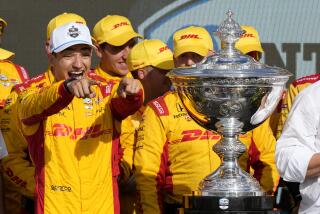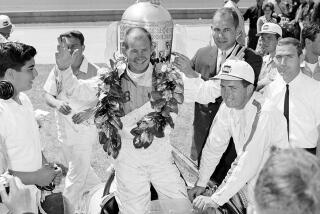For the Car Owner at Indy, Preparation is No. 1
- Share via
INDIANAPOLIS — EDITOR’S NOTE -- This is the third in a four-part series of first-person columns by team-owners with cars entered in the May 27 Indianapolis 500. This column is by Steve Horne, who looks at the importance of preparation for Indy.
We don’t come to Indy thinking about winning the race.
All our preparation and focus is on the details, no matter how small, with the knowledge that when we take care of the little things, the big things take care of themselves.
We started preparing for this year’s Indianapolis 500 the day after last year’s race was over. That’s when we made the same lodging and travel reservations and began thinking about what we’d learned from the previous day’s race that could help us win this year.
This year is the first time we’re running two cars here, so we’re doubling our efforts and staffing on all fronts. At the same time, though, we’re just duplicating what we already know.
We will spend $1 million during the month of May here, and while that is a lot of money, it’s a pretty realistic figure when you consider we brought four cars, 12 engines, 60 wheels and enough backup spares and parts so that we don’t have to take pieces off one car to take care of another.
Also included in that amount, of course, is the travel, lodging and meals for our crew members, as well as the basic wear and tear on equipment that is to be expected when you’re running for two weeks or more.
They key to all this is to keep organized, and in order to do that, we plan as much as we can and keep that plan as rigid as possible. Even to set up our pit area for the day’s work, we have an extremely details checklist that covers everything from the number of wheels that must be there to radios to the water kegs.
Every morning at 8 o’clock in our grage we have a “prayer meeting” of both crews. We go over everything that happened the day before and discuss our plans for that day.
For example, we had some electrical problems in one of our cars that we solved, and we made some fairly good modifications on the other car. After that, I went into another meeting with our engineers.
Having two drivers is a luxury we’ve never enjoyed before, and it’s already paid dividends. With Geoff Brabham, who’s driving one of our Lolas, away with his IMSA (sports car) obligations, Raul Boesel, who has replaced the injured Scott Pruett in our other Lola for the year, did most of the setup driving for Indianapolis. As a result, we took the setup on Raul’s car straightaway to Geoff’s, and Geoff ran 217 (mph) with no problems whatsoever.
By the time we get to Phoenix for the first race of the season, in early April, we’re already pointing to Indy, and we’ve discovered that much of what we learn at Phoenix International Raceway can be applied to the Indianapolis Motor Speedway.
Once you arrive at Indianapolis, however, everything is magnified by the length of the time we’re here, the intensity of the atmosphere, the attention of the media, obligations to our sponsors, and everything else that constitutes the month of May around here.
I know the first time we came to Indy, in 1982, we were so awed by the place and the atmosphere that we just tried to survive. And that we only did by hanging on by our fingernails.
That’s why it’s so imperative that you stay organized. And what you’re doing, essentially, is preparing for two events in three weeks -- first, qualifying, and then, the race itself.
Once we’ve qualified, and everyone plans on that happening the first week of time trials, we return to our headquarters in suburban Columbus, Ohio, the following Tuesday or Wednesday. It’s quiet there, everyone’s home with their wife and kids at night, and it really recharges our batteries for the race to come.
Then it’s back to Indy for carburetion day (the final on-track warmup Thursday of race week), and the pressure just keeps building from then on because, no matter what you do, you feel like you’re in a cage. By the morning of the race, in some ways, a full year has been devoted to our preparations for the Indianapolis 500. And, if we’re not prepared by then, we’re in the wrong business, believe me.
More to Read
Go beyond the scoreboard
Get the latest on L.A.'s teams in the daily Sports Report newsletter.
You may occasionally receive promotional content from the Los Angeles Times.










